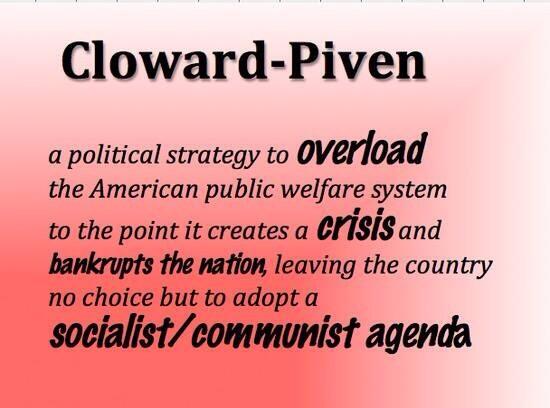With the flood of diseased illegals flooding the country, people have been talking about Obama using the Cloward and Piven strategy to bring down this country. But what exactly is the Cloward-Piven Strategy? It was devised during the 1960 by two far left progressive liberal Democrats Richard Cloward and Frances Fox Piven to overwhelm the welfare system and bring down capitalism. Frances Fox Piven is still alive today and indoctrinating at The Graduate Center, City University of New York. Of course Obama and the progressive liberal Democrats have done the best they can to overwhelm the system by keeping the economy down and forcing millions of Americans on to welfare. Now, with the influx of hundreds of thousands of illegals, this could finally finish the job that Obama, Valarie Jarrett and the Democrats started.

|
| What is the Cloward-Piven Strategy? |
|---|
The Cloward–Piven strategy is a political strategy outlined in 1966 by American sociologists and political activists Richard Cloward and Frances Fox Piven that called for overloading the U.S. public welfare system in order to precipitate a crisis that would lead to a replacement of the welfare system with a national system of “a guaranteed annual income and thus an end to poverty”. Cloward and Piven were a married couple who were both professors at the Columbia University School of Social Work. The strategy was formulated in a May 1966 article in the liberal[1] magazine The Nation titled “The Weight of the Poor: A Strategy to End Poverty”.[2]
The two stated that many Americans who were eligible for welfare were not receiving benefits, and that a welfare enrollment drive would strain local budgets, precipitating a crisis at the state and local levels that would be a wake-up call for the federal government, particularly the Democratic Party. There would also be side consequences of this strategy, according to Cloward and Piven. These would include: easing the plight of the poor in the short-term (through their participation in the welfare system); shoring up support for the national Democratic Party-then splintered by pluralistic interests (through its cultivation of poor and minority constituencies by implementing a national “solution” to poverty); and relieving local governments of the financially and politically onerous burdens of public welfare (through a national “solution” to poverty)